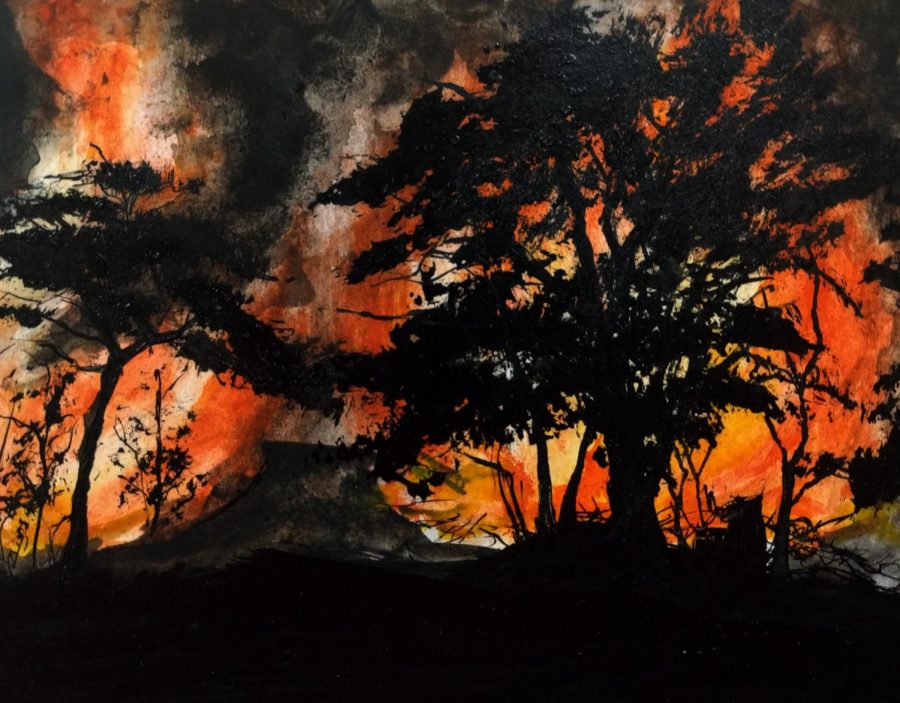California’s Raging Infernos
January 13, 2018
Vicious wildfires continue to ravage through California, destroying everything in their paths through January of 2018. Firefighters in California have battled the deadly wildfires ever since the beginning of 2017, but they continue to burn relentlessly. Due to the unprecedented destruction, people began to raise questions: Why are they occurring so often now? Are they due to human activity?
Although wildfires often cause harm, they play an important role in nature. By burning dead and decaying matter, wildfires return nutrients to the soil, which is more efficient than waiting for the matter to decompose itself. Additionally, they can remove plants with diseases and harmful insects from an environment. Burning forest vegetation may seem destructive at first, but it actually clears the forest, allowing new plants and crops to grow with direct sunlight.
However, recent wildfires differ from past events, becoming increasingly deadly and frequent. In 2016, a total of 7,389 fires burned through California, stretching a total area of 560,815 acres. But this year, there have already been 8,766 wildfires, scorching 1,254,367 acres. Studies have also shown that large forest fires in the western US have been occurring nearly five times more often since the 1970s and 1980s. They have burned more than six times the land compared to those decades and have lasted almost five times longer.
What factors are creating these destructive infernos? Temperatures associated with climate change increase evaporation, allowing more moisture to be drawn from the soil, making the land drier. Higher spring and summer temperatures also cause earlier spring snowmelt, prolonging the dry season, and ultimately increasing the chances of drought and a longer wildfire season, especially on the West Coast.
The drought that parched California for years left dry vegetation. But in the winter of 2016 and the spring of 2017, there were record amounts of rainfall, which brought about new plant growth. Months of extreme temperature followed, withering the plants. Something as large as lightning striking a tree to something as little as someone carelessly throwing a cigarette into a forest can start a fire. To top it off, diablo winds—hot, dry winds from the northeast—arriving in California at speeds of 70 mph or more, set the perfect conditions for a forest fire.
Besides burning down acres of land, California’s famous Napa Valley faces catastrophic damage. The wine business alone is a difficult economic venture; too much rain or too little rain, extended periods of heat, viruses, insects, and many other factors trouble the farmers who grow the grapes needed for wine. In October, the Napa Valley fires destroyed 220,00 acres of land, 2,800 homes, leaving 41 people dead. This famed wine industry employs 40% of the Napa County workforce, generating over $50 billion per year. Now, Napa Valley has to begin rebuilding vineyards, but many may lose employment because of the lack of land and wineries to work at. But their crops may need more years to recover. Even when the flames are out, smoke damage could be equally disastrous for the crops.
Additionally, many species will not have a place to nest and live. Unfortunately, there will also be food shortages for them because many plant species take decades before growing back, so animals are forced to migrate to a sustainable habitat. For example, the Soberanes Fire in July burned through large areas of sagebrush near Big Sur, and sagebrush provides food and shelter to more than 300 species, such as lizards and songbirds. However, it takes up to 40 to 50 years for sagebrush to regrow after invasive weeds take over. As a result, many species will have to move to find a habitable place. Similarly, places with high wildfire risks, including forests, places with high temperatures, arid climates, and strong winds force people to move.
The wildfires in the past year destroyed homes and crops, and it may be an alert for the society to become more mindful of their actions. Preventative measures must be taken to curb these wildfires from spreading even further. Communities can create buffer zones between homes and susceptible forests and everyone must reduce their impact on the climate. As Jaclyn Chen ’21 advocates, “We must work together to prevent climate change so both humans and animals can stay safe!”

